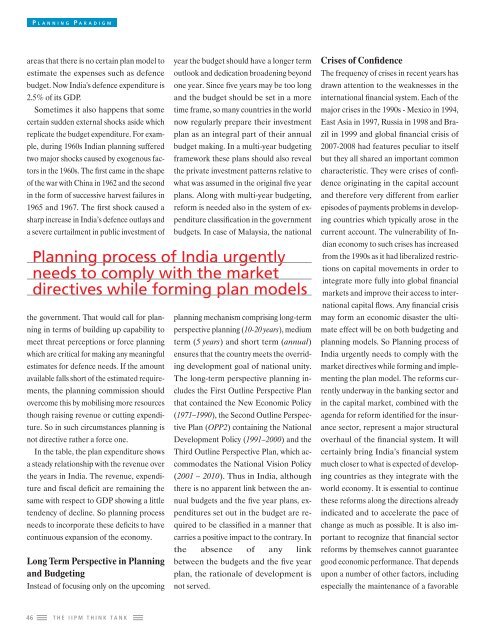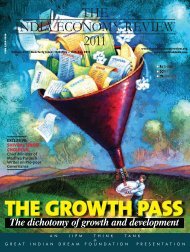Download - The India Economy Review
Download - The India Economy Review
Download - The India Economy Review
Create successful ePaper yourself
Turn your PDF publications into a flip-book with our unique Google optimized e-Paper software.
P LANNING P ARADIGM<br />
areas that there is no certain plan model to<br />
estimate the expenses such as defence<br />
budget. Now <strong>India</strong>'s defence expenditure is<br />
2.5% of its GDP.<br />
Sometimes it also happens that some<br />
certain sudden external shocks aside which<br />
replicate the budget expenditure. For exam-<br />
ple, during 1960s <strong>India</strong>n planning suffered<br />
two major shocks caused by exogenous factors<br />
in the 1960s. <strong>The</strong> fi rst came in the shape<br />
of the war with China in 1962 and the second<br />
in the form of successive harvest failures in<br />
1965 and 1967. <strong>The</strong> fi rst shock caused a<br />
sharp increase in <strong>India</strong>’s defence outlays and<br />
a severe curtailment in public investment of<br />
the government. That would call for planning<br />
in terms of building up capability to<br />
meet threat perceptions or force planning<br />
which are critical for making any meaningful<br />
estimates for defence needs. If the amount<br />
available falls short of the estimated requirements,<br />
the planning commission should<br />
overcome this by mobilising more resources<br />
though raising revenue or cutting expenditure.<br />
So in such circumstances planning is<br />
not directive rather a force one.<br />
In the table, the plan expenditure shows<br />
a steady relationship with the revenue over<br />
the years in <strong>India</strong>. <strong>The</strong> revenue, expenditure<br />
and fi scal defi cit are remaining the<br />
same with respect to GDP showing a little<br />
tendency of decline. So planning process<br />
needs to incorporate these defi cits to have<br />
continuous expansion of the economy.<br />
Long Term Perspective in Planning<br />
and Budgeting<br />
Instead of focusing only on the upcoming<br />
46 THE IIPM THINK TANK<br />
year the budget should have a longer term<br />
outlook and dedication broadening beyond<br />
one year. Since fi ve years may be too long<br />
and the budget should be set in a more<br />
time frame, so many countries in the world<br />
now regularly prepare their investment<br />
plan as an integral part of their annual<br />
budget making. In a multi-year budgeting<br />
framework these plans should also reveal<br />
the private investment patterns relative to<br />
what was assumed in the original fi ve year<br />
plans. Along with multi-year budgeting,<br />
reform is needed also in the system of expenditure<br />
classifi cation in the government<br />
budgets. In case of Malaysia, the national<br />
Planning process of <strong>India</strong> urgently<br />
needs to comply with the market<br />
directives while forming plan models<br />
planning mechanism comprising long-term<br />
perspective planning (10-20 years), medium<br />
term (5 years) and short term (annual)<br />
ensures that the country meets the overriding<br />
development goal of national unity.<br />
<strong>The</strong> long-term perspective planning includes<br />
the First Outline Perspective Plan<br />
that contained the New Economic Policy<br />
(1971–1990), the Second Outline Perspective<br />
Plan (OPP2) containing the National<br />
Development Policy (1991–2000) and the<br />
Third Outline Perspective Plan, which accommodates<br />
the National Vision Policy<br />
(2001 – 2010). Thus in <strong>India</strong>, although<br />
there is no apparent link between the annual<br />
budgets and the fi ve year plans, expenditures<br />
set out in the budget are required<br />
to be classifi ed in a manner that<br />
carries a positive impact to the contrary. In<br />
the absence of any link<br />
between the budgets and the fi ve year<br />
plan, the rationale of development is<br />
not served.<br />
Crises of Confi dence<br />
<strong>The</strong> frequency of crises in recent years has<br />
drawn attention to the weaknesses in the<br />
international fi nancial system. Each of the<br />
major crises in the 1990s - Mexico in 1994,<br />
East Asia in 1997, Russia in 1998 and Brazil<br />
in 1999 and global fi nancial crisis of<br />
2007-2008 had features peculiar to itself<br />
but they all shared an important common<br />
characteristic. <strong>The</strong>y were crises of confi -<br />
dence originating in the capital account<br />
and therefore very different from earlier<br />
episodes of payments problems in developing<br />
countries which typically arose in the<br />
current account. <strong>The</strong> vulnerability of <strong>India</strong>n<br />
economy to such crises has increased<br />
from the 1990s as it had liberalized restrictions<br />
on capital movements in order to<br />
integrate more fully into global fi nancial<br />
markets and improve their access to international<br />
capital fl ows. Any fi nancial crisis<br />
may form an economic disaster the ultimate<br />
effect will be on both budgeting and<br />
planning models. So Planning process of<br />
<strong>India</strong> urgently needs to comply with the<br />
market directives while forming and implementing<br />
the plan model. <strong>The</strong> reforms currently<br />
underway in the banking sector and<br />
in the capital market, combined with the<br />
agenda for reform identifi ed for the insurance<br />
sector, represent a major structural<br />
overhaul of the fi nancial system. It will<br />
certainly bring <strong>India</strong>’s fi nancial system<br />
much closer to what is expected of developing<br />
countries as they integrate with the<br />
world economy. It is essential to continue<br />
these reforms along the directions already<br />
indicated and to accelerate the pace of<br />
change as much as possible. It is also important<br />
to recognize that fi nancial sector<br />
reforms by themselves cannot guarantee<br />
good economic performance. That depends<br />
upon a number of other factors, including<br />
especially the maintenance of a favorable





